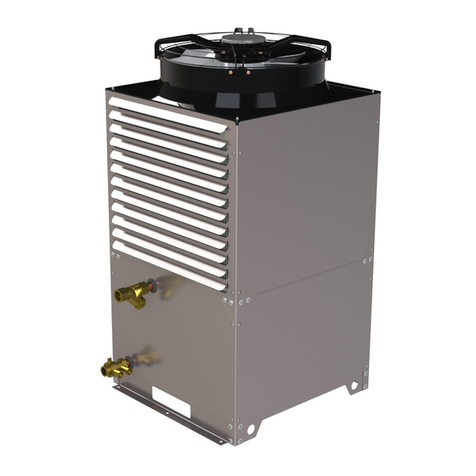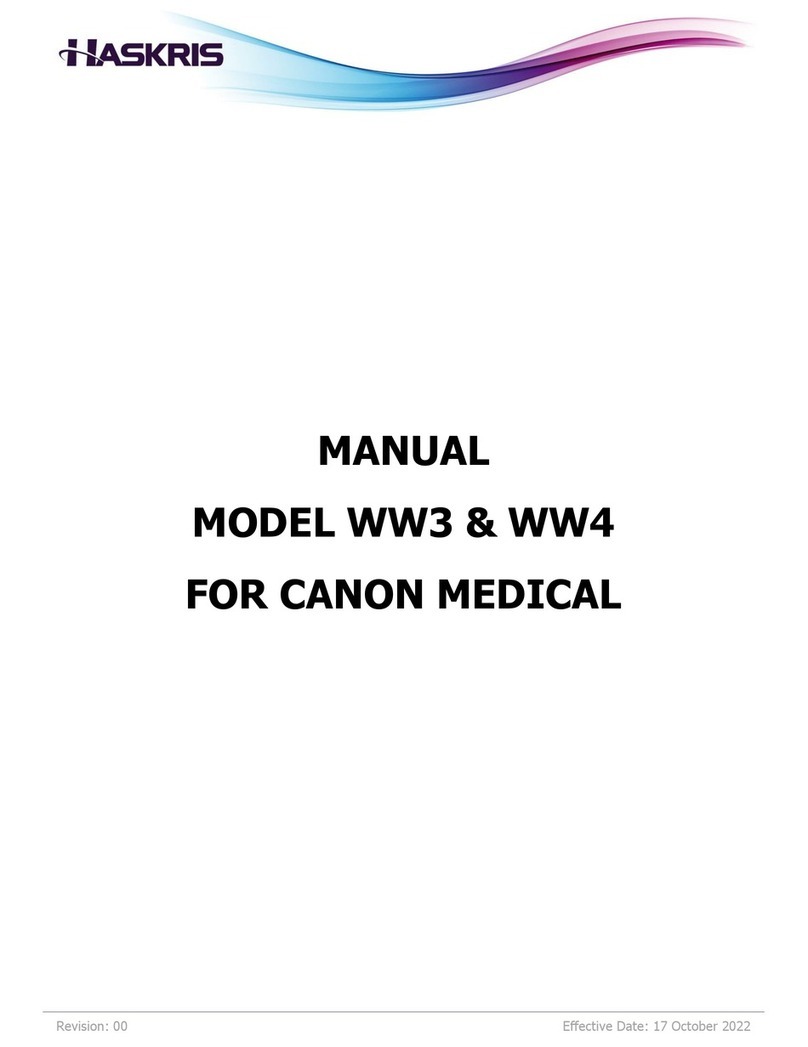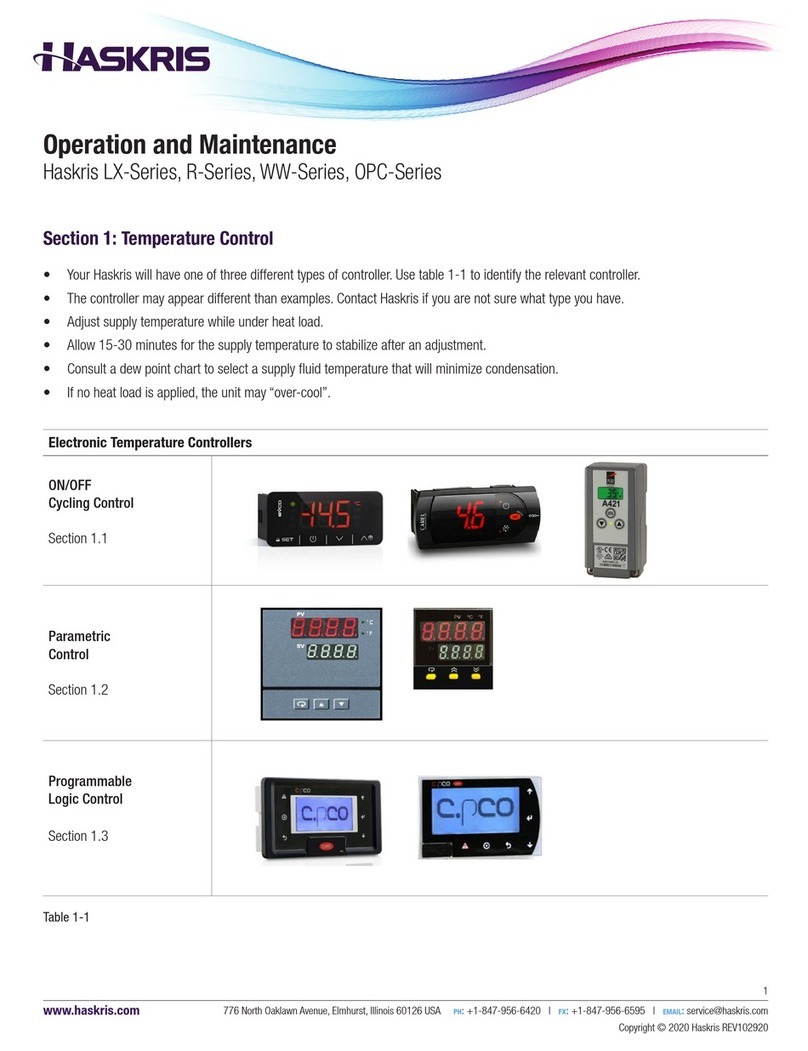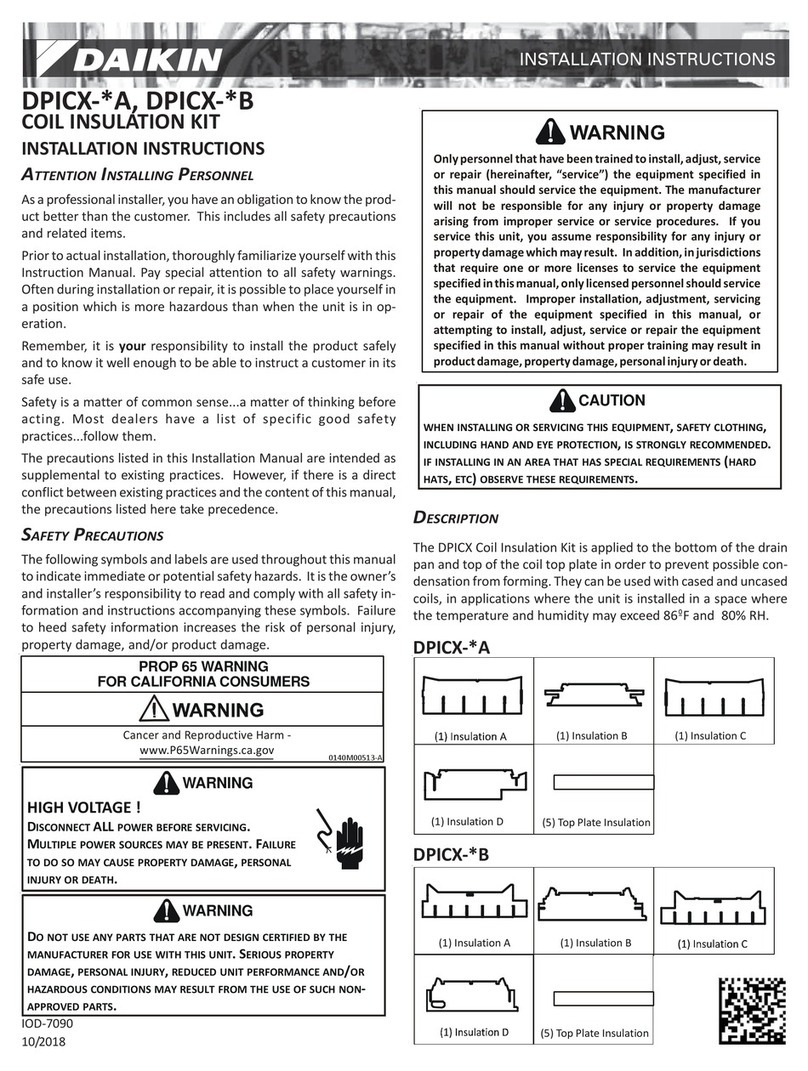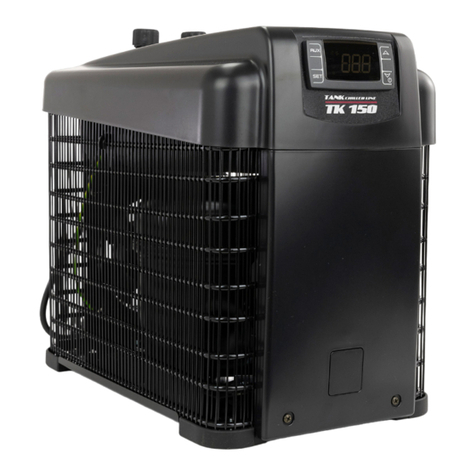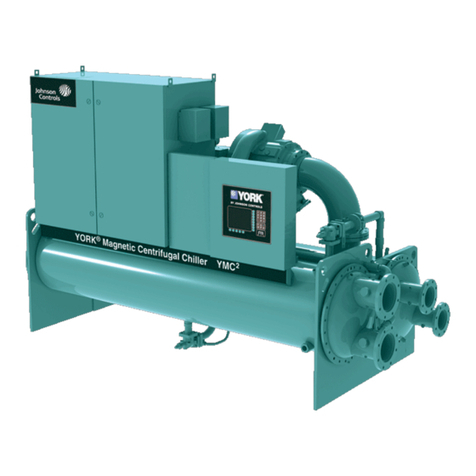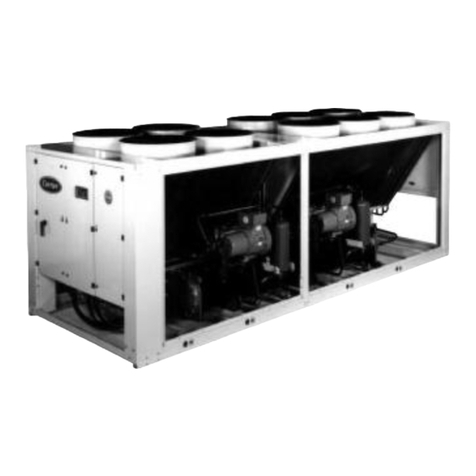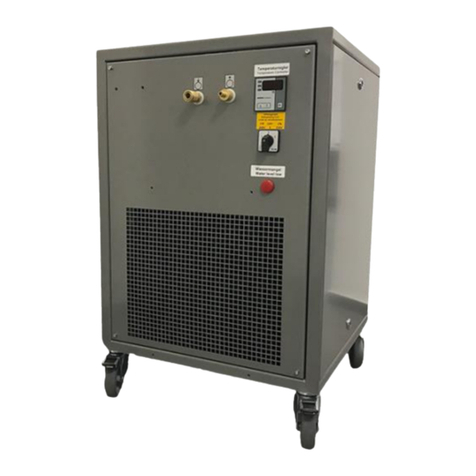Haskris OPC3-OPC15 User manual

Effective Date: 02 September 2022
Revision: 00
MANUAL
MODELS OPC3 THROUGH OPC60

Page 2 of 46
Phone: 001 847 956 6420
Email: service@haskris.com
Table of Contents
I. Haskris Contact Information .................................................................................5
II. Confirm Chiller Model and Number of Frame Sections
Frame Sections ...............................................................................................6
III. Installation: Foundation, Vibration, Elevation, Clearances, Transportation
Foundation .....................................................................................................7
Vibration ........................................................................................................9
Elevation ...................................................................................................... 10
Clearances.................................................................................................... 10
Transportation –OPC3 through OPC30...........................................................14
Transportation –OPC36 through OPC60......................................................... 17
IV. Installation: Line Sizing, Piping
Line Sizing....................................................................................................18
Piping...........................................................................................................19
V. Installation: Electrical
Electrical ......................................................................................................21
VI. Installation: Piping Flush, Purge
Piping Flush.................................................................................................. 23
Piping Purge .................................................................................................23
VII. Installation: Glycol Mixture, Filling
Glycol Mixture...............................................................................................24
Fill the Reservoir –Standard Type (Non-Pressurized) ......................................25
Fill the Reservoir –Optional Sealed Type (Pressurized).................................... 25
Fill the Piping................................................................................................ 26

Page 3 of 46
Phone: 001 847 956 6420
Email: service@haskris.com
VIII. Installation: Final Checks
Phase Monitor............................................................................................... 27
Controller Faults ........................................................................................... 27
IX. Optional Modbus or BACnet Communication Capability
Building Management System ........................................................................28
Haskris Capability..........................................................................................28
Physical Connection ......................................................................................29
Settings Configuration ...................................................................................29
Baud Rate Support........................................................................................30
X. Startup
Phase Monitor............................................................................................... 31
ON/OFF Switch .............................................................................................32
Pump Priming ...............................................................................................33
Pump Supply Pressure...................................................................................34
XI. Controller Display
Main Display .................................................................................................35
Status Modes................................................................................................35
Adjusting Set Value (sv) ................................................................................36
Units of Measure........................................................................................... 36
Faults...........................................................................................................38

Page 4 of 46
Phone: 001 847 956 6420
Email: service@haskris.com
XII. Chiller Features
E-coated Condensers for Corrosion Resistance................................................ 40
Dynamic Capacity Control..............................................................................40
Local Monitoring ...........................................................................................41
Remote ON/OFF Contacts.............................................................................. 42
Optional Feature –Remote Control Panel ....................................................... 43
Optional Feature –Redundant Primary/Standby Pumps................................... 44
Optional Feature –Louvered Hail Guard Panels...............................................44
XIII. Maintenance
Frequency .................................................................................................... 45
Glycol Mixture...............................................................................................45
Wye Strainer................................................................................................. 46
Condenser Coils ............................................................................................46
Electrical Inspection ......................................................................................46

Page 5 of 46
Phone: 001 847 956 6420
Email: service@haskris.com
I. Haskris Contact Information
Contact Haskris with any questions about a unit and/or the information in this manual. Haskris has a
team of engineers available to answer questions, troubleshoot issues, or provide supplemental
information as needed.
Phone: 001 847 956 6420

Page 6 of 46
Phone: 001 847 956 6420
Email: service@haskris.com
II. Confirm Chiller Model and Number of Frame Sections
Frame Sections
Details: The Haskris OPC series chillers are built with a system of parallel refrigeration circuits and
associated frame sections to house those components. Larger models of chiller have more
refrigeration circuits and more frame sections.
Instructions: Use the chiller model and the table below to determine the number of refrigeration
circuits and sheet metal sets are used in the design.
Haskris Chiller Model
Refrigeration Circuits
Frame Sections*
OPC3 through OPC15
1
1
OPC16 through OPC26
2
2
OPC30
2
3
OPC36
3
3 or 4
OPC48
4
4 or 5
OPC60
5
5 or 6
*Some units are designed with customizations that may change the number of frame sections
Refrigeration Circuits and Frame Sections by Model

Page 7 of 46
Phone: 001 847 956 6420
Email: service@haskris.com
III. Installation: Foundation, Vibration, Elevation, Clearances,
Transportation
Foundation
•The chiller must be installed on a level concrete foundation, level roof curb, or level perimeter
beam system.
•Comply with local codes for proper anchoring and vibration isolation.
•Use of a level roof curb or perimeter beam system requires the specifying engineer to identify
all necessary materials of construction, thickness, and additional bracing or supports.
•See the diagrams below for mounting hole locations.
oNote that the example in the drawings has a cutaway that shows 2.5 frame sections.
The actual number of sections varies, refer to the prior section for details.
•Point load at each mounting location is 200 lbs. or less.
Mounting Hole Locations for Non-OSHPD Sites

Page 9 of 46
Phone: 001 847 956 6420
Email: service@haskris.com
Vibration
•The chiller does not require vibration isolation on the mounting for the chiller to operate
normally.
•The motors in the chiller are hard mounted to the metal structure of the chiller. They are not
internally isolated.
•It is common for the chiller to be hard mounted directly to a pad on grade, roof curb, or
perimeter beam system.
•If vibration transmission to the building structure is a concern, an engineer should provide a
detailed specification for vibration damping.
•There are two common approaches
oRubber or synthetic pads between the chiller and the mounting
oSpring vibration isolators. These cannot be installed directly between the chiller and the
mounting. The chiller must be mounted on a perimeter beam. The spring vibration
isolators can be installed between the beam and the mounting.
OSHPD: If OSHPD compliance is required and isolators are used, the spring isolators must comply
with Haskris OSHPD OSP-0673 file.

Page 10 of 46
Phone: 001 847 956 6420
Email: service@haskris.com
Elevation
For chillers located at a
higher
elevation than the application
•The maximum recommended height difference varies depending on several factors including
the maximum inlet water pressure for the application, normal water pump discharge pressure,
and pressure losses in the piping to the application.
•Consult Haskris if there are questions about locating a chiller.
For chillers located at a
lower
elevation than the application
•The maximum recommended height difference is 32 ft (9.8 m).
oIt is best if the height difference can be less than 32 ft (9.8 m).
oConsult Haskris if there are questions.
Clearances
•See the diagrams below showing recommended clearances for chiller models OPC3 through
OPC30.
oNote that these show the dimensions and clearances for a standard design. Some
customizations may alter the dimensions and/or clearance requirements. Consult
Haskris if there are questions about a specific design.
•For models OPC36 and larger, consult Haskris to get information about recommended
clearances.
•Air flow is horizontal into the chiller and vertical out of the chiller.
•Maintain an unobstructed space for free air discharge above the chiller.
•Consult Haskris if clearances will be smaller than these recommendations. Haskris will evaluate
individual site conditions as needed to ensure proper operation.
•Avoid areas where a heat source will discharge heat towards the chiller.
oExamples: condenser vents, heating exhaust, etc.
•Avoid areas where debris may accumulate on the condenser.

Page 14 of 46
Phone: 001 847 956 6420
Email: service@haskris.com
Transportation –OPC3 through OPC30
•Transport the chiller using the fork pockets or rigging lift points. Ensure forks are past the
chiller center post.
•If rigging the chiller, lift only from the points shown below. Proper rigging technique, including
spreader bars, is critical to avoid damaging the chiller.
•Do not remove any panels from the chiller during the rigging process.
•See below for rigging and lift points.
Weights
OPC3-OPC15
OPC16-OPC26
OPC30
Chiller with
packaging
1,200 lbs
544 kg
2,200 lbs
998 kg
3,000 lbs
1,361 kg
Empty without
packaging
900 lbs
408 kg
1,800 lbs
817 kg
2,300 lbs
1,043 kg
Full installed
with fluid
1,100 lbs
499 kg
2,000 lbs
907 kg
3,000 lbs
1,361 kg
Weights

Page 18 of 46
Phone: 001 847 956 6420
Email: service@haskris.com
IV. Installation: Line Sizing, Piping
Line Sizing
Contact Haskris for help: Haskris is available to review pipe runs, pressure drop, etc. and make
recommendations for individual sites.
Approach to line sizing
•Size all interconnecting hose and piping equal to or larger than the connections on the chiller.
•Pressure drop in the external piping is a function of fluid flow rate, pipe inner diameter, pipe
length, the number and type of fittings, and other factors.
•Generally, external piping should be sized to minimize pressure drop. Approximately 5 psi to
10 psi (0.34 bar to 0.7 bar) or less is a good goal
For applications requiring approximately 50 LPM (13.2 GPM) or less
•If the total straight pipe length is less than 1,100 ft (335 m) use 1-1/2” nominal pipe size (ID).
For applications requiring approximately 100 LPM (23.8 GPM) or less
•If the total straight pipe length is less than 300 ft (91.4 m) use 1-1/2” nominal pipe size (ID).
•If the total straight pipe length is less than 1,200 ft (366 m) use 2” nominal pipe size (ID).
For applications requiring approximately 150 LPM (31.7 GPM) or less
•If the total straight pipe length is less than 120 ft (36.6 m) use 1-1/2” nominal pipe size (ID).
•If the total straight pipe length is less than 500 ft (152 m) use 2” nominal pipe size (ID).
For applications requiring approximately 200 LPM (52.8 GPM) or less
•If the total straight pipe length is less than 50 ft (15.2 m) use 1-1/2” nominal pipe size (ID).
•If the total straight pipe length is less than 310 ft (94.5 m) use 2” nominal pipe size (ID).
•If the total straight pipe length is less than 925 ft (282 m) use 2-1/2” nominal pipe size (ID).

Page 19 of 46
Phone: 001 847 956 6420
Email: service@haskris.com
Piping
•Comply with local codes for proper piping.
•Use type L copper piping and non-ferrous materials. Do not use black steel piping.
•Insulate piping to minimize condensation.
•Terminate the beginning and ends of hard runs with vibration isolators.
•Ensure piping is clean and free of flux at solder joints.
•Install manual ball valves at high points in the piping for purging air while filling the lines.
oIf automatic purge valves are used, isolation ball valves should be installed before the
purge valves.
oPurge valves must be closed during normal operation.
•Install drain valves at the base of every rise for emptying the lines.
•Install a heat trace on piping exposed to temperatures below +20°F (-6.7°C). Cover heat trace
with closed cell UV resistant insulation. Power the heat trace from a dedicated disconnect.
oHeat trace is specified to provide additional protection against freezing in a scenario
where the chiller loses power during extremely cold ambient conditions for an extended
period of time.
•Label supply and return lines over insulation with arrows indicating flow directions.
•Install isolation ball valves on the supply and return connections at the chiller.
•Install flush ports with isolation valves after the supply and return ball valves.
•Sleeve and insulate pipe penetrations through all roof and/or walls.
•Install a loop of reinforced opaque hose between supply and return connections at indoor
location for flushing.
•After the lines are flushed, connect the lines to the application.
Devices that are not recommended: Haskris does not recommend that any of the following are used
in the piping system, without consultation with Haskris.
•Chemical feeder systems
•Expansion tanks
•Electronic regulation or shut off valves
This manual suits for next models
2
Table of contents
Other Haskris Chiller manuals
Popular Chiller manuals by other brands
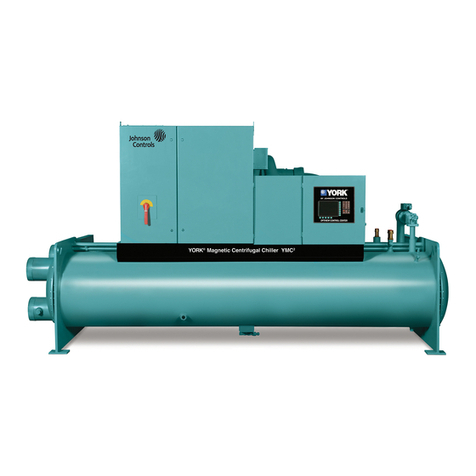
York
York R-134a Operation and maintenance manual
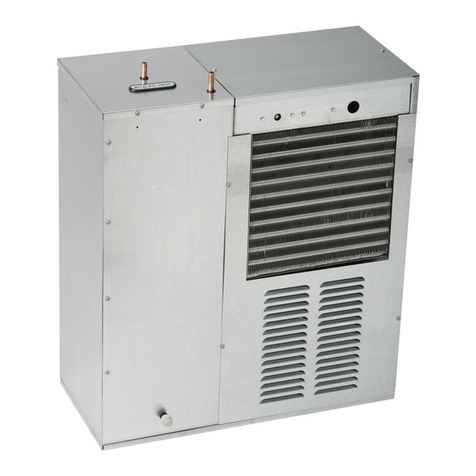
Elkay
Elkay ER19 Specifications

TICA
TICA TCAV-BHE Installation & operation manual

Johnson Controls
Johnson Controls YORK YMC2 installation manual
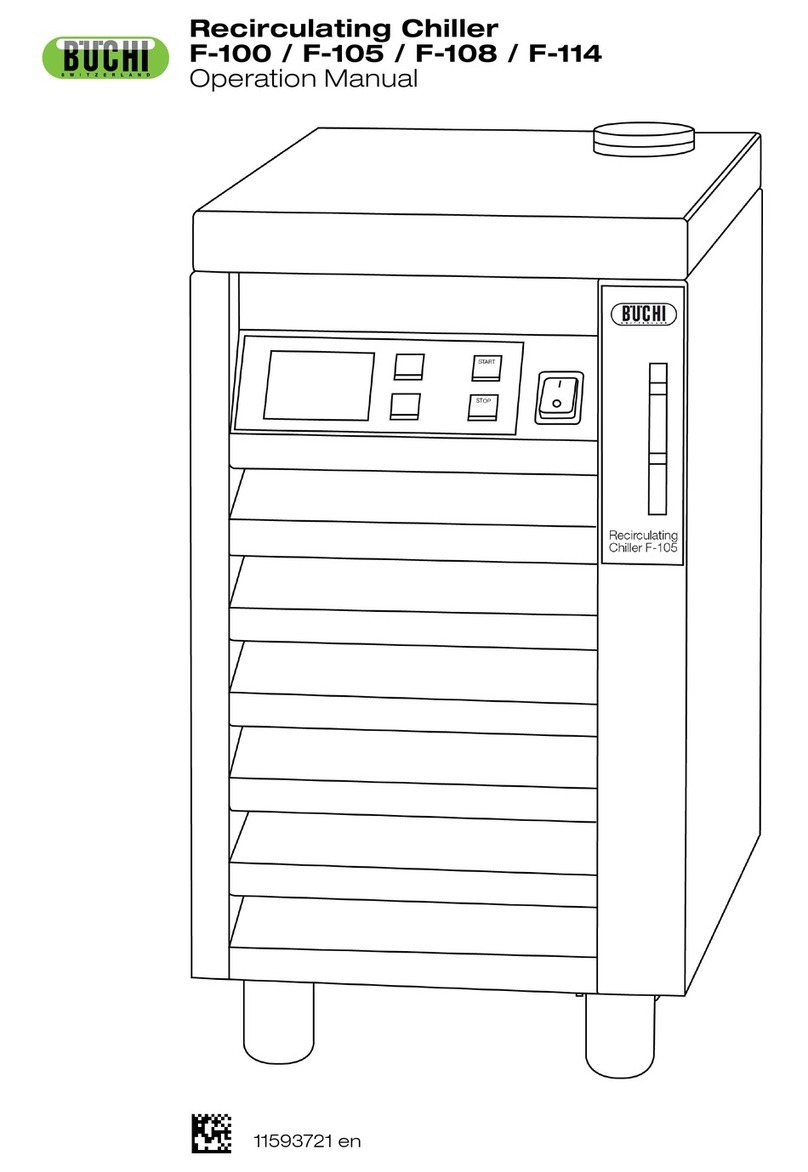
Buchi
Buchi F-108 Operation manual

Carrier
Carrier Aqua Force 30XA Installation, operation and maintenance instructions









